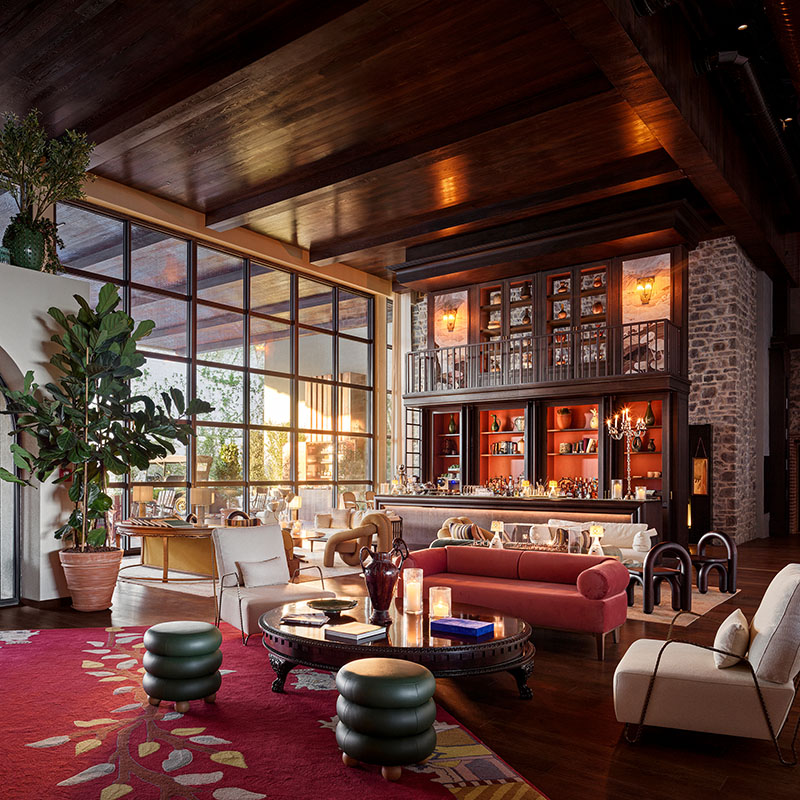Share—
Copied
08 MAY 2024
The design process has always been rooted in research of a building’s surroundings, but for The Hoxton, Vienna, it’s also a celebration of the building’s history.
Our in-house interior design studio, AIME Studios, creates environments that flourish functionally and inspire creativity. Putting the guest experience at the forefront of mind, AIME Studios created the familiar layered yet accessible aesthetic that The Hoxton has become renowned for. For their most recent project, The Hoxton Vienna, their designs are a nod to Viennese traditions and culture.
Originally built as an office block, AIME Studios was tasked with turning the 1950s Carl Appel-designed building into The Hoxton’s most recent outpost. The brief: 196 keys, a lobby complete with a ground floor F&B outlet and The Hox’s signature events space, The Apartment; a rooftop bar and a swimming pool; basement bar; and the brand’s very first Auditorium.
Constructed between 1952 and 1954 and serving as an Office Building for the Chamber of Commerce for Vienna, the building is well-respected and beloved by locals. It boasts beautiful original listed features such as a green marble and travertine façade, a centrally arranged staircase that runs through the entire building, and aluminium-wrapped columns, terrazzo floors, and travertine walls in the lobby.
The studio’s goal for the project was simple: create a design that respects the building’s history, preserves its architectural style and 1950s aesthetics, and inject new life into the property.
The process typically begins with intense research to get to know the new city—and in Vienna, they had a wealth of cultural heritage to draw from. Old and new at the same time, Vienna is a juxtaposition of traditional tastes, highly respectful of buildings and institutions of the past, but also inviting in progressive newness. For the project, building architect Carl Appel’s mid-century aesthetic, as well as the iconic Wiener Werkstätte movement that began in Vienna, formed the foundations for the hotel’s interior design scheme.
Durable materials, clean lines, and a simple colour palette draw inspiration from the principles of Modernism, whilst a celebration of the outdoors can be found through the building through an abundance of greenery. Throughout the hotel, locally sourced vintage furniture and bespoke rugs add to The Hoxton’s signature homey vibes – the team worked with The Federal Monuments Authority Austria to select items that reflect the 1950s and protect and maintain Austria’s cultural heritage – while bold tiling, feel like a playful running thread connecting the different spaces.
In the expansive, light-filled double-height lobby, the original travertine-clad walls and terrazzo flooring remain, framing the space. Dressed with ruby red sofas, statement 1950s-inspired armchairs, lush greenery, and mid-century lighting, it’s a welcoming space for locals and visitors alike. A bespoke large abstract botanical piece by Austrian artist Rini Spiel demands attention in the lobby, while an oil painting of the iconic Konzerthaus facade by local artist Rudolf Fitz is another hero piece. A dramatic back-lit staircase to the rear of the lobby adds a touch of drama.
The hotel’s guestrooms reference early 20th-century Austrian design, from the geometric patterned curtains influenced by iconic Wiener Werkstätte fabrics to the statement ruched headboards inspired by renowned architect Adolf Loos. Rooms feel calm and inviting, with local photography and 1950s-inspired art on the walls, bold painted ceilings, warm wooden accents and parquet flooring. Accessories give reference to the previous history as an office space. Bathrooms feature cool blue or glossy black tiles, warm wooden trims, grey terrazzo tiled floors and chrome fixtures.
Design at each of the hotel’s three food and beverage outlets are distinct, subtly transporting you. Bouvier, tucked off to the right of the lobby, is bold with a checkerboard terrazzo floor, deep red wall panelling, 1950s-inspired custom seating, and an open kitchen. Serving up a menu of New York meets European food with creativity and sass, retro advertising posters hark back to iconic New York culture. At the same time, locally-sourced vintage pieces pay homage to the restaurant’s immediate surroundings.
For the underground cocktail bar, Salon Paradise, AIME took inspiration from traditional speakeasies from the 1950s. A burl-timber bar stands strong in the centre of the space, while corners feel cosy and snug with aged leather banquettes, textured fabrics, low ceilings, and hand-written postcards dating to the Prohibition era.
Head to the rooftop and guests are transported to 1950s Cuba by way of its tropical interiors. A saffron-hued Bauwerk corridor and red and black checkerboard floor lead you into the main restaurant space, which is dressed with bespoke rattan furniture. Bright blue ceramic-tiled columns add energy to the space, and bright, bold artwork captures the spirit of Havana.
Finally, for The Hoxton’s grandest event space to date, The Auditorium, AIME pulled out all the stops. Classic 1950s cinema culture heavily inspired the nostalgic look and feel of the space and branding; bold colour-blocked ceilings contrast burl timber accents, a patinated metal bar front, 1950s vintage chandeliers, and heavy velvet drapery. With its own dedicated entrance, the 143 sqm space has tiered cinema-style balcony seating, striped walls, electric blue drapes, a large floor space that can be set up in a number of ways, and two fully-stocked bars that will help facilitate it as an exciting new destination for live music and entertainment.
At The Hoxton Vienna, AIME Studios celebrated the diversity and originality of Vienna’s streets and scenes with welcoming spaces punctuated with a touch of “Weiner Schmäh” (the city’s characteristic dark and witty humour).
More Stories

